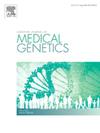进一步描述erf相关的Chitayat综合征
IF 1.7
4区 医学
Q3 GENETICS & HEREDITY
引用次数: 0
摘要
Chitayat综合征(CHYTS)是一种常染色体显性遗传病,由位于19q13.2的ETS2抑制因子(ERF)基因变异引起。这个基因编码ERF蛋白。该综合征极为罕见,迄今为止仅报道了13例患者。我们报道了一例由ERF (NM_001429.3)基因中的c.1201_1202del (p.Lys401Glufs * 10)移码变体引起的CHYTS患者。患者为一名10岁女孩,表现出身材矮小、面部畸形和早期发育迟缓等典型特征。由于身材矮小,她接受了5年的重组人生长激素治疗。在治疗过程中,未发现颅内压升高、甲状腺功能减退或胰腺功能障碍等并发症。然而,生长响应不理想,总高度增加25.4 cm。该患者为与ERF(NM_001429.3)基因变异相关的临床表现和治疗结果提供了有价值的见解,有助于现有的知识,并可能帮助临床医生了解类似的患者。本文章由计算机程序翻译,如有差异,请以英文原文为准。
Further delineation of ERF-related Chitayat syndrome
Chitayat syndrome (CHYTS) is an autosomal dominant disorder caused by variants in the ETS2 repressor factor (ERF) gene, located on 19q13.2. This gene encodes the ERF protein. The syndrome is extremely rare, with only 13 patients reported to date. We present a patient of CHYTS resulting from a c.1201_1202del (p.Lys401Glufs∗10) frameshift variant in the ERF (NM_001429.3) gene. The patient, a 10-year-old girl, exhibited typical features of the syndrome such as short stature, facial dysmorphism, and early developmental delay. She was treated with recombinant human growth hormone for ∼5 years due to her short stature. During treatment, no complications such as increased intracranial pressure, hypothyroidism, or pancreatic dysfunction were noted. However, the growth response was suboptimal, with a total height increase of 25.4 cm. This patient provides valuable insights into the clinical manifestations and treatment outcomes associated with ERF(NM_001429.3) gene variants, contributing to the existing knowledge and potentially aiding clinicians in understanding similar patients.
求助全文
通过发布文献求助,成功后即可免费获取论文全文。
去求助
来源期刊
CiteScore
4.10
自引率
0.00%
发文量
193
审稿时长
66 days
期刊介绍:
The European Journal of Medical Genetics (EJMG) is a peer-reviewed journal that publishes articles in English on various aspects of human and medical genetics and of the genetics of experimental models.
Original clinical and experimental research articles, short clinical reports, review articles and letters to the editor are welcome on topics such as :
• Dysmorphology and syndrome delineation
• Molecular genetics and molecular cytogenetics of inherited disorders
• Clinical applications of genomics and nextgen sequencing technologies
• Syndromal cancer genetics
• Behavioral genetics
• Community genetics
• Fetal pathology and prenatal diagnosis
• Genetic counseling.

 求助内容:
求助内容: 应助结果提醒方式:
应助结果提醒方式:


